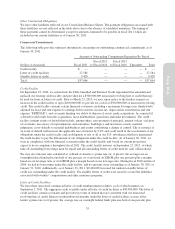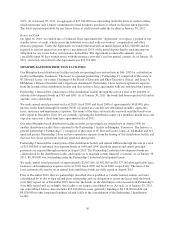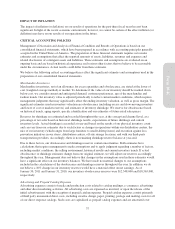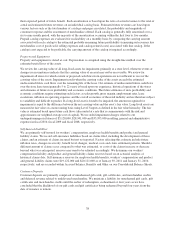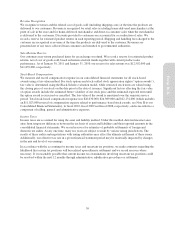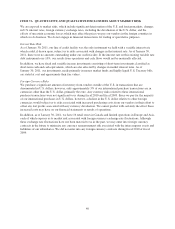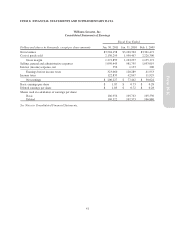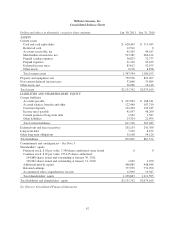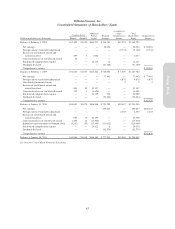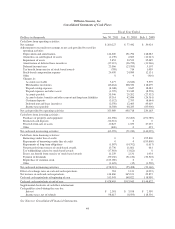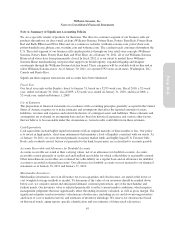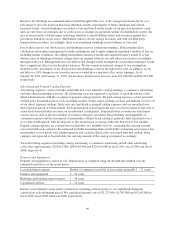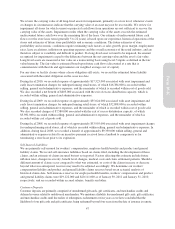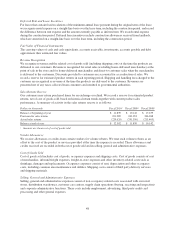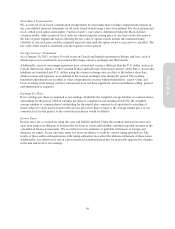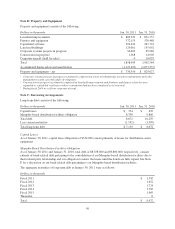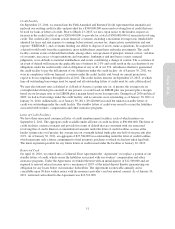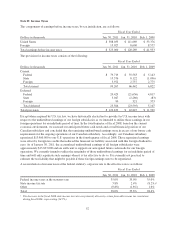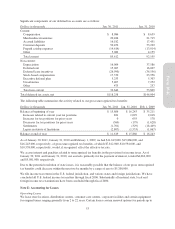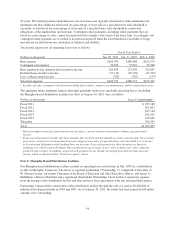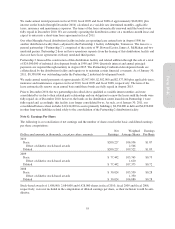Pottery Barn 2010 Annual Report Download - page 59
Download and view the complete annual report
Please find page 59 of the 2010 Pottery Barn annual report below. You can navigate through the pages in the report by either clicking on the pages listed below, or by using the keyword search tool below to find specific information within the annual report.
Williams-Sonoma, Inc.
Notes to Consolidated Financial Statements
Note A: Summary of Significant Accounting Policies
We are a specialty retailer of products for the home. The direct-to-customer segment of our business sells our
products through our six direct-mail catalogs (Williams-Sonoma, Pottery Barn, Pottery Barn Kids, Pottery Barn
Bed and Bath, PBteen and West Elm) and six e-commerce websites (williams-sonoma.com, potterybarn.com,
potterybarnkids.com, pbteen.com, westelm.com and wshome.com). The catalogs reach customers throughout the
U.S. The retail segment of our business sells similar products through our four retail store concepts (Williams-
Sonoma, Pottery Barn, Pottery Barn Kids and West Elm). As of January 30, 2011, all of our Williams-Sonoma
Home retail stores have been permanently closed. In fiscal 2011, it is our intent to market those Williams-
Sonoma Home merchandising categories that support our bridal registry, expanded flagship and designer
assortments through the Williams-Sonoma kitchen brand. These categories will be available both on-line and in
select Williams-Sonoma stores. As of January 30, 2011, we operated 592 stores in 44 states, Washington, D.C.,
Canada and Puerto Rico.
Significant intercompany transactions and accounts have been eliminated.
Fiscal Year
Our fiscal year ends on the Sunday closest to January 31, based on a 52/53-week year. Fiscal 2010, a 52-week
year, ended on January 30, 2011; fiscal 2009, a 52-week year, ended on January 31, 2010; and fiscal 2008, a
52-week year, ended on February 1, 2009.
Use of Estimates
The preparation of financial statements in accordance with accounting principles generally accepted in the United
States of America requires us to make estimates and assumptions that affect the reported amounts of assets,
liabilities, revenues and expenses and related disclosures of contingent assets and liabilities. These estimates and
assumptions are evaluated on an ongoing basis and are based on historical experience and various other factors
that we believe to be reasonable under the circumstances. Actual results could differ from these estimates.
Cash Equivalents
Cash equivalents include highly liquid investments with an original maturity of three months or less. Our policy
is to invest in high-quality, short-term instruments that maintain a level of liquidity consistent with our needs. As
of January 30, 2011, we were invested primarily in money market funds and highly liquid U.S. Treasury bills.
Book cash overdrafts issued, but not yet presented to the bank for payment, are reclassified to accounts payable.
Accounts Receivable and Allowance for Doubtful Accounts
Accounts receivable are stated at their carrying values, net of an allowance for doubtful accounts. Accounts
receivable consist primarily of credit card and landlord receivables for which collectability is reasonably assured.
Other miscellaneous receivables are evaluated for collectability on a regular basis and an allowance for doubtful
accounts is recorded as deemed necessary. Our allowance for doubtful accounts was not material to our financial
statements as of January 30, 2011 and January 31, 2010.
Merchandise Inventories
Merchandise inventories, net of an allowance for excess quantities and obsolescence, are stated at the lower of
cost (weighted average method) or market. To determine if the value of our inventory should be marked down
below cost, we consider current and anticipated demand, customer preferences, age of the merchandise and
fashion trends. Our inventory value is adjusted periodically to reflect current market conditions, which requires
management judgments that may significantly affect the ending inventory valuation, as well as gross margin. The
significant estimates used in inventory valuation are obsolescence (including excess and slow-moving inventory
and lower of cost or market reserves) and estimates of inventory shrinkage. We reserve for obsolescence based
on historical trends, aging reports, specific identification and our estimates of future retail sales prices.
45
Form 10-K


